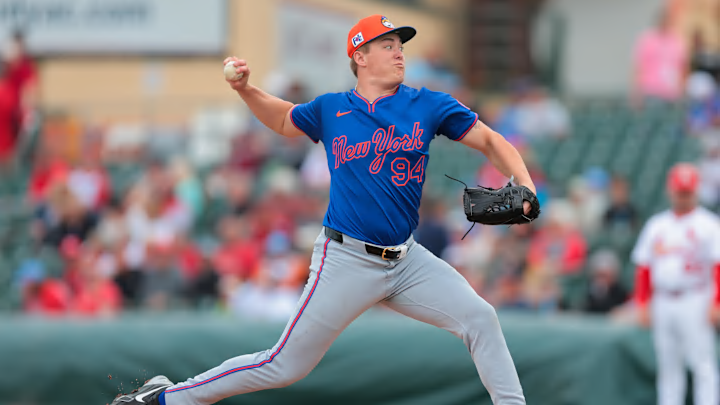The New York Mets’ rotation has faced some notable injuries. After starting 32 games last year, Sean Manaea was seen as an anchor to the rotation when the Mets re-signed him to a three-year contract. But he has since opened the year on the injured list due to an oblique issue, and recently suffered a set-back in his recovery. Frankie Montas, another offseason addition, also started 30 games in 2024 but went on the IL with a high-grade lat strain before the start of spring training and is still recovering.
Although the Mets’ starters have mostly been performing well to open 2025, another hit to the depth chart could make them turn to the minor leagues for a replacement until someone heals up. Brandon Sproat is an obvious answer as someone we could see before the start of June, but these three are other options we could see the Mets turn to in the event they need another starter.
1) Blade Tidwell
Blade Tidwell was heading into 2024 on the heels of a promising 2023 season. However, he had a disappointing year. After a strong start to the year at Double-A, Tidwell was promoted to Triple-A Syracuse, where he struggled mightily. The right-hander had a 5.93 ERA, 6.44 FIP, and 1.57 WHIP in 85 innings. He only struck out 19.7% of batters, with a walk rate clocking in at 13.7%. But even worse was his 1.80 HR/9 ratio.
Tidwell’s 2025 will be an important season, given he will be Rule 5 draft-eligible this offseason and will be fighting for a 40-man roster spot. His first two starts have produced mixed results. Tidwell’s first outing of ‘25 saw him pitch five innings, striking out five opponents, only walk one, and allow just one walk. His next start only lasted 3.1 innings, as he allowed four earned runs, struck out four, and walked three. He also gave up a home run.
While it’s only been two starts, one thing is for certain, and that’s his stuff looks a lot better than last year. Tidwell’s four-seamer only averaged out at 94.8 MPH with 13.6 inches of downward movement and 6.5 inches of arm-side run. Now, he’s up to 97 MPH with only 11.7 inches of drop and 7.4 inches of run. Tidwell’s two-seamer has also gained a significant amount of velo, going from 93.7 MPH to 96.1 MPH with more ride, but similar arm-side break.
While his slider hasn’t gained nor lost any velocity, it’s gained more break, going from 6.5 inches of arm-side movement to 10 inches of break in that direction. His change-up has gained about two ticks of velo while keeping up a similar movement profile. He’s yet to throw a curveball or cutter, two pitches he semi-frequently mixed in last year.
The improvements Tidwell has made with his pitch arsenal this year are promising. Hopefully, it translates into better performance this year compared to last season (although that’s not a very high bar to start with). Regardless, if Tidwell puts up some solid results and can carry his velocity deeper into pitch counts, the Mets will likely see what he can offer at the Major League level before summer.
